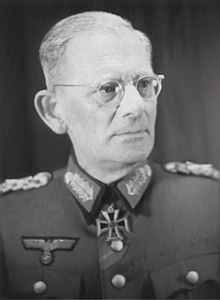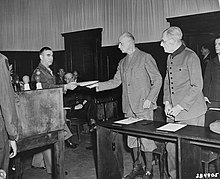Maximilian von Weichs
Maximilian von Weichs | |
|---|---|
 Weichs as Generalfeldmarschall c. 1943-45 | |
| Born | 12 November 1881 Dessau, German Empire |
| Died | 27 September 1954 (aged 72) Bonn, West Germany |
| Allegiance | |
| Service/ | |
| Years of service | 1900–45 |
| Rank | |
| Commands held | 1st Panzer Division XIII Corps 2nd Army Army Group B Army Group F OB Südost |
| Battles/wars | World War I |
| Awards | Knight's Cross of the Iron Cross with Oak Leaves |
| Signature | |
Maximilian Maria Joseph Karl Gabriel Lamoral Reichsfreiherr[a] von und zu Weichs an der Glon (12 November 1881 – 27 September 1954) was a German Generalfeldmarschall (Field Marshal) in the Wehrmacht of Nazi Germany during World War II.
Born into an aristocratic family, Weichs joined the Bavarian cavalry in 1900 and fought in the First World War. At the outbreak of the Second World War he commanded the XIII Corps in the invasion of Poland. He later commanded the 2nd Army during the invasions of France, Yugoslavia and the Soviet Union.
In August 1942 during Case Blue, the German offensive in southern Russia, he was appointed commander of Army Group B. In 1944, Weichs commanded Army Group F in the Balkans overseeing the German retreat from Greece and most of Yugoslavia. During the Nuremberg Trials, Weichs was implicated in war crimes committed in the Balkans and was scheduled to take part in the US Army's Hostages Trial. He was removed from the proceeding for "medical reasons" without having been judged or sentenced.
Early life and career[edit]
World War I[edit]
Born in 1881 into an aristocratic family, Maximilian von Weichs entered the Bavarian Cavalry in 1900 and participated in World War I as a staff officer. After the war he remained in the newly created Reichswehr where he worked at a number of General Staff positions.
Inter-war years[edit]

Transferred from the 3rd Cavalry Division to command Germany's 1st Panzer Division upon its formation in October 1935, he led the unit in maneuvers that impressed Army Commander in Chief Werner von Fritsch.[1] Weichs' aristocratic and cavalry credentials demonstrated the continuing influence of these military elites in Germany's modernizing force.[2] In October 1937 he became the commander of the XIII Army Corps, that later served in the 1938 German annexation of the Sudetenland.
World War II[edit]
This section needs additional citations for verification. (May 2022) |

To prepare for the German invasion of Poland beginning World War II in 1939, Weichs was appointed head of his own Army Corps "Weichs". After the Polish surrender, he was made Commander-in-Chief of the 2nd Army, a part of Rundstedt's Army Group A in the West. After the Battle of France, he was awarded the Knight's Cross of the Iron Cross and promoted to colonel-general. Leading his army, Weichs later took part in the Balkans Campaign, and in preparation for Operation Barbarossa, the German invasion of the Soviet Union, he was assigned to lead the 2nd Army as a part of Fedor von Bock’s Army Group Centre. He led the 2nd Army in 1941 through the Battle of Kiev, the Battle of Smolensk, and then on to Vyazma and Bryansk.

In 1942, for Fall Blau, Weichs was assigned to lead the newly created Army Group B.[3] Army Group B was composed of Salmuth's 2nd Army, Hoth’s 4th Panzer Army, and Paulus's 6th Army. In addition to the German armies, Army Group B included the 2nd Hungarian Army, 8th Italian Army, the Third and the Fourth Romanian Armies. The 6th Army was assigned to take the city of Stalingrad and cover approximately 800 km of front.

The Soviet Operation Uranus broke through the Romanian armies on his flanks, cutting off the 6th Army inside Stalingrad. Suggesting retreat, Weichs fell out of Hitler’s favor. Consequently, parts of Army Group B were taken away from the command of Weichs and incorporated into a new "Army Group Don", led by Manstein. Later in February, the remaining part merged with the Don Group into a newly reinstated Army Group South, also led by Manstein. Weichs was relieved of command.
Weichs was promoted to Field Marshal on 1 February 1943. In August 1943 Weichs was appointed Commander of Army Group F in the Balkans directing operations against local partisan groups. Since August 1943 Weichs was also OB Südost, commander-in-chief of the German occupied Greece and the Balkans (Yugoslavia, Albania and Thrace) whose headquarters were first in Belgrade and since 5 October 1944 in Vukovar.[4] In April 1944 Weichs was appointed to the position of commander of all German troops stationed in Hungary.[5] In late 1944, he oversaw the German retreat from Greece and most of Yugoslavia.
Post-War years[edit]

Weichs retired from his Military Career on 25 March 1945 and was arrested by American troops in May. During the Nuremberg Trials, Weichs was said to be implicated in war crimes committed while suppressing the partisans. He was removed from the US Army's Hostages Trial for medical reasons without having been judged or sentenced.[6]
He died on 27 September 1954 in Bonn, West Germany at the age of 72.[7]
Awards[edit]
- Iron Cross of 1914 2nd Class (20 September 1914) & 1st Class (12 November 1915)[8]
- Clasp to the Iron Cross of 1939 2nd Class (18 September 1939) & 1st Class (29 September 1939)[8]
- Knight's Cross of the Iron Cross with Oak Leaves
Promotions[edit]
- Fahnenjunker: 15 July 1900
- Leutnant: 12 March 1902
- Oberleutnant: 3 March 1911
- Hauptmann: 1914
- Major: 1 February 1921
- Oberstleutnant: 1 February 1928
- Oberst: 1 November 1930
- Generalmajor: 1 April 1933
- Generalleutnant: 1 April 1935
- General der Kavallerie: 1 October 1936
- Generaloberst: 19 July 1940
- Generalfeldmarschall: 1 February 1943
Notes[edit]
- ^ Reichsfreiherr is a German title of nobility, usually translated as Baron of the Empire. Freiherr is a title usually translated as Baron, and Reich is usually translated as Empire. The female forms are Reichsfreifrau and Reichsfreiin. Titles using the prefix Reichs- were not created after the fall of the Holy Roman Empire.
References[edit]
Citations[edit]
- ^ Showalter 2009, p. 47.
- ^ Showalter 2009, p. 59.
- ^ Adam, Wilhelm; Ruhle, Otto (2015). With Paulus at Stalingrad. Translated by Tony Le Tissier. Pen and Sword Books Ltd. p. 25. ISBN 9781473833869.
- ^ Brett-Smith 1977, p. 172"From August 1943 von Weichs, now a field-marshal, was C-in-C Yugoslavia, Albania, and Thrace, with headquarters first in Belgrade and — from 5 October 1944 — at Vukovar."
- ^ Wistrich 2002, p. 272.
- ^ "Subsequent Nuremberg Proceedings, Case #7, The Hostage Case". encyclopedia.ushmm.org. Retrieved 2023-09-24.
- ^ "VON WEICHS IS DEAD; A NAZI COMMANDER". The New York Times. 1954-09-29. ISSN 0362-4331. Retrieved 2023-09-24.
- ^ a b Thomas 1998, p. 422.
- ^ a b Scherzer 2007, p. 772.
Bibliography[edit]
- Goda, Norman (2005). "Black Marks: Hitler's Bribery of his Senior Officers During World War II". In Kreike, Emmanuel; Jordan, William Chester (eds.). Corrupt Histories. Toronto: Hushion House. pp. 96–137. ISBN 978-1-58046-173-3. Originally published as: Goda, Norman (June 2000). "Black Marks: Hitler's Bribery of his Senior Officers During World War II". The Journal of Modern History. 72 (2): 413–452. doi:10.1086/315994. S2CID 154044694.
- Hürter, Johannes (2006). Hitlers Heerführer - Die deutschen Oberbefehlshaber im Krieg gegen die Sowjetunion 1941/42 (in German). München, Germany : Oldenbourg: Oldenbourg. ISBN 978-3-486-57982-6.
- Megargee, Geoffrey P. (2000). Inside Hitler's High Command. Lawrence, Kansas: Kansas University Press. ISBN 0-7006-1015-4.
- Scherzer, Veit (2007). Die Ritterkreuzträger 1939–1945 Die Inhaber des Ritterkreuzes des Eisernen Kreuzes 1939 von Heer, Luftwaffe, Kriegsmarine, Waffen-SS, Volkssturm sowie mit Deutschland verbündeter Streitkräfte nach den Unterlagen des Bundesarchives [The Knight's Cross Bearers 1939–1945 The Holders of the Knight's Cross of the Iron Cross 1939 by Army, Air Force, Navy, Waffen-SS, Volkssturm and Allied Forces with Germany According to the Documents of the Federal Archives] (in German). Jena, Germany: Scherzers Militaer-Verlag. ISBN 978-3-938845-17-2.
- Showalter, Dennis E. (2009). Hitler's Panzers: The Lightning Attacks That Revolutionized Warfare. New York: Berkley. ISBN 978-0-425-23004-6.
- Stahel, David (2015). The Battle for Moscow. Cambridge, UK: Cambridge University Press. ISBN 978-1-107-08760-6.
- Thomas, Franz (1998). Die Eichenlaubträger 1939–1945 Band 2: L–Z [The Oak Leaves Bearers 1939–1945 Volume 2: L–Z] (in German). Osnabrück, Germany: Biblio-Verlag. ISBN 978-3-7648-2300-9.
- Wistrich, Robert S. (2002). Who's who in Nazi Germany. Psychology Press. ISBN 978-0-415-26038-1.
- Brett-Smith, Richard (1977). Hitler's generals. Presidio Press. ISBN 978-0-89141-044-7.
- 1881 births
- 1954 deaths
- Barons of Germany
- German Army personnel of World War I
- German Army World War II field marshals
- Major generals of the Reichswehr
- Military personnel from Saxony-Anhalt
- People from Dessau-Roßlau
- People indicted by the United States Nuremberg Military Tribunals
- People indicted for crimes against humanity
- People indicted for war crimes
- Recipients of the clasp to the Iron Cross, 1st class
- Recipients of the clasp to the Iron Cross, 2nd class
- Recipients of the Knight's Cross of the Iron Cross with Oak Leaves
- German prisoners of war in World War II held by the United States
